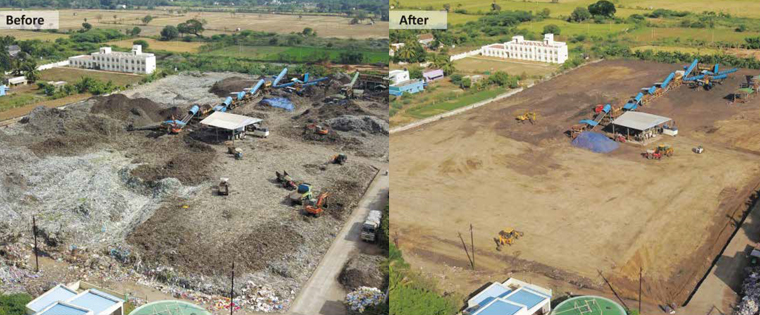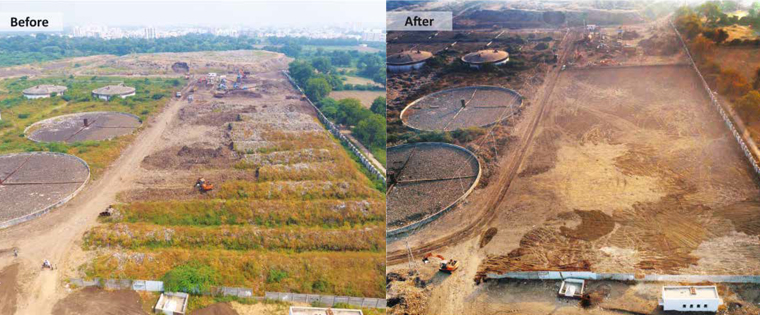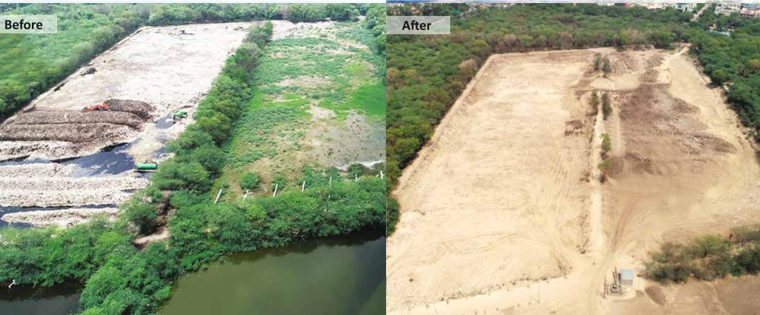The smelly garbage mountains in our cities—with hawks hovering over them and stray dogs, cows and rats wandering at will—are the greatest reminders of our irresponsible attitude. Years of neglect and indiscriminate dumping of Municipal Solid Waste (MSW), generated from households and bulk waste generators like apartment complexes and hotels, formed these massive mountains. Many countries practise open dumping as a final disposal method for MSW, which not only causes surface water pollution, but the leachate (dark liquid) discharge from the dumpsite also pollutes the groundwater irreversibly. A dumpsite containing 0.1 million tonne of waste reportedly has a potential to generate 2,770 tonne of methane every year, which is equivalent to 69,250 tonne of carbon dioxide emissions. Methane is estimated to have a global warming potential that is 84 times greater than carbon dioxide. To make this worse, methane in the landfills is particularly dangerous―t often auto-ignites, causing fires in dumpsites and generating smoke and emissions, thereby causing severe air pollution.
What is bio-mining?
Governments around the world have recognised the problem and over the years landfill mining or bio-mining has become a popular method of excavating waste from active or closed landfills and segregating the aggregates generated with an ultimate purpose to clear them and reclaim the land. Urban India accounts for a third of India’s population and generates 54.75 million tonne of MSW annually. From 2014 onwards, the Swachh Bharat Mission has been emphasising on reclamation of landfill sites to adhere to the Solid Waste Management (SWM) Rules, 2016, and the guidelines of the Hon National Green Tribunal, with an aim to recover over an estimated 10,000 hectares of urban land that is locked in these dumpsites in India. Urban India has been struggling to set up infrastructure in solid waste management, which requires a huge land bank, and land reclamation could truly solve this problem and enable a turnaround in scientific management of MSW in the country.
Bio-mining was mandated by the SWM Rules, 2016, wherein it was a preferred methodology over ‘capping’ which simply meant covering the waste with soil. This, however, did not solve the problem of water pollution that continued unabated and the land could not be reclaimed.
B Dharmaraj, Managing Director, Zigma Global Environ Solutions Private Limited, which offers Landfill Mining services, says, “Landfills are a continuous source of pollution, and the only solution is to mine and process them. Until this happens, the water, air and soil contamination will continue steadily. Integrated landfill mining enables complete outsourcing of activity by the urban and local bodies (ULBs), thus enabling a dedicated approach toward reclamation.”
This is where bio-mining or landfill mining becomes a viable solution for the reclamation of these large sites. Different fractions of aggregates are segregated from the dumpsite and recycled, reused or repurposed in a suitable way, thereby cleaning the environment and also resulting in financial value and resource flow. Bio-mining is the best way to remediate open dumpsites to achieve zero emission of landfill gases and leachate, and reclamation of land to be used for other purposes.
 Ajith Singh Nagar dumpsite in Andhra Pradesh before
and after biomining and land reclamation
Ajith Singh Nagar dumpsite in Andhra Pradesh before
and after biomining and land reclamation
“There is a misconception that bio-mining is just segregation,” says A. Rajasekaran, President- Technical, Zigma Global Environ Solutions Pvt. Ltd. “These landfills are quite often biologically active, owing to the haphazard dumping, which does not allow the organics to degrade completely. Hence, the waste needs to be first stabilised or bio-remediated, as a result of which the fly menace, odour, scavenging animals and birds just vanish. It also results in the moisture getting onto optimum levels wherein the waste is now apt for segregation and processing.”
Challenges of bio-mining
 Kumbakonam dumpsite in Tamil Nadu before and after biomining and land reclamation
Kumbakonam dumpsite in Tamil Nadu before and after biomining and land reclamation
The CPCB Guidelines on Disposal of Legacy Waste 2019 provides a detailed methodology on how the process has to be carried out and the means by which the aggregates generated can be responsibly disposed. This requires sophisticated machinery and a flawless approach towards maintaining the quality of aggregates so that they can be disposed responsibly. In India, the waste is delivered in the landfills after multiple levels of scavenging, as a result of which most of the aggregates which can fetch commercial value cease to exist. Hence, there needs to be a certain amount of cost involved to dispose these aggregates.
Advantages of bio-mining
So with waste disposal becoming a critical area for communities around the world, and with the Indian government now mandating bio-mining and bioremediation, let’s look at the advantages:
✦ The process generates near zero emissions and leaves near zero residues.
✦ Some of the aggregates generated from the process like refuse-derived fuel can be reused, recycled or repurposed, thus exerting less pressure on the economy to use virgin natural resources like fossil fuels.
✦ The process puts a permanent end to the source of pollution and hence the degradation of underground water resource, surface water and soil contamination stops.
✦ With the dumpsite vanishing, the residents staying close by can breathe a sigh of relief; no more bad odour.
✦ The complete land which is reclaimed can be put to alternate use especially to develop facilities in better management of solid waste, ensuring another landfill does not come up at the mining site.
✦ Greenhouse gas emissions reduce significantly.
✦ Landfills are a breeding ground for flies and mosquitos. Clearing the landfills can help immensely decrease the prevalence of vector-borne diseases.
Zigma benchmarks bio-mining processes
In March 2015, the five co-founders of Zigma came together with one objective to do something of social value in the field of waste management. This was around the same time that Prime Minister Narendra Modi had announced the Swachh Bharat mission with an aim to make India clean for future generation.
“In keeping with the spirit of Make in India, which the government was aggressively promoting at the time, Zigma designed, fabricated and financed its own mobile MSW plant with the help of its inhouse engineering team who were hired from different industries,” says Dharmaraj
 Atladara dumpsite in Gujarat before and after biomining and land reclamation
Atladara dumpsite in Gujarat before and after biomining and land reclamation
A decade ago, India’s fresh waste processing plant dumped waste termed as “rejects” in the landfill sites which turned out to be also responsible for these giant landfills standing tall today. Zigma wanted to customise the machine to ensure that there was fine segregation that can support near zero concept. It therefore did not opt for machines that did not offer this. Armed with its very own mobile MSW plant, Zigma embarked on its first project in Kumbakonam, Tamil Nadu, which required reclamation of a 12-acre dumpsite, filled with 1,10,000 cubic meters of solid waste. In just six months, the enterprise cleared over 60,000 metric tonne of waste, reclaiming
a remarkable 3.5 acre of land. The project was a first-ofits kind integrated model with zero residues tried anywhere in India. A team from Supreme Court Panel Members and Ministry of Housing and Urban Affairs visited the plant, which was featured in the SBM Best Practices. Following this, the project was showcased in the first Swachh Sarvekshan in 2016, recommending all the Urban and Local Bodies to implement a similar model in their respective dumpsites.
 A dumpsite in Noida before and after biomining and
land reclamation
A dumpsite in Noida before and after biomining and
land reclamation
Since then, the company has gone from strength to strength and has been introducing the integrated landfill mining model to the ULBs. “It is like the dumpsite is outsourced to us wherein we take care of everything―setting up the plant, stabilisation of waste, segregating the waste with state-of-the-art plants and then recycling, reusing or, in some cases, finding other uses for the aggregates generated,” says Dharmaraj.
The three Ts
Zigma has been introducing a holistic approach in the Indian Solid Waste Management sector which was looking for an efficient solution with transparency. Zigma follows the three Ts―technology, transparency and testing―n their operations. “The scalability, efficiency and technology of our machines are responsible for the disposal of aggregates,” says Dharmaraj. “We hence lay high emphasis on continuous research, development and innovation.”
Dharmaraj believes that transparency in operations iswhat makes them stand apart from competition. The company has designed its own ERP system which provides live data feed to the ULBs. This includes 24x7 video monitoring of operations, automated weighbridge data live update with unique data-like truck picture capturing. Further, a system is incorporated which provides aerial view of reclamation of the land at every stage, captured using drones.
“All the officials concerned can access the information anytime and monitor the dumpsite 24x7. Transparency and traceability of the materials were almost non-existent earlier and Zigma has benchmarked this in the landfill mining projects in India, being the first organisation to implement this procedure. Traceability― where you send these aggregates very important and needs to be monitored,” says Rajasekaran. “Otherwise, the risk of contamination that is now limited to the dumpsite can go offsite.”
In 2016, Zigma tied up with a South Korean landfill mining major company Forcebel, which has cleared more than a hundred landfill sites across the world. The collaboration with Forcebel was envisioned for developing the most advanced landfill mining system in the world, with a very high focus on quality, scalability and technology in India. Zigma uses its expertise in implementing some of the best practices in landfill mining and implementing projects in extreme situations like in lakes and river sides or in low temperatures. Forcebel’s reclaimed sites across the world have been converted into residential complexes, subway stations and football stadiums among others. The collaboration was a feather in the cap and helped Zigma upgrade its already customised efficient segregation systems to ensure flawless quality of aggregates and achieve its vision of achieving near zero residues.
Zigma lays high emphasis on its testing of aggregates before disposal and has worked its way in achieving the same. The company collaborated with reputed institutes like IIT, Mumbai to undertake research and provide advisory in methodologies for aggregate disposal. Zigma now has tie-ups with various laboratories across the country with NABL and MoEF accreditation to undertake various tests. These tests are carried out in strict adherence to SWM Rules and CPCB Guidelines. In addition, the company ensures an in-house laboratory being set up at every project site for certain tests that need to be carried out before everyday disposal of aggregates.
“There were no standards for landfill mining and bioremediation earlier,” says Rajasekaran. “But the government―both at the Centre and the states―is very proactive, and a lot of initiatives are being taken up, including the CPCB guidelines to ensure that responsible disposal has been undertaken.” Why is testing so important? Dharmaraj elucidates, “Testing not only confirms whether the aggregates are safe to dispose but also allows to decide if any further treatment is required before the same can be disposed offsite.”
One of the aggregates which is a segregated combustible fraction, consisting of low value/non-recyclable plastics, cloth, bags, polyester material, tyres, rubber and wood, is converted into refuse-derived fuel and sent to cement plants to be used as alternate fuel (as a replacement to coal) or to Waste to Energy plants to incinerate and produce energy.
The company has grown in a sustainable manner from 2016. It began with 30 people and today employs more than a thousand people. As of now, Zigma has cleared over 25 lakh tonne of legacy waste and cleared over 125 acres of land which is equivalent to about 1.69 million tonne of carbon dioxide emissions saved.
Also, the refuse-derived fuel generated from the dumpsites has successfully replaced fossil fuel and helped save 45,000 tonne of carbon dioxide emission, which is equivalent to carbon sequestered by 59,254 acres of US forests in one year. For Zigma, it is not only important to remove and process the waste but also using the waste to replace depleting commodities like fossil fuels and reduce greenhouse gas emissions.
The recovery cost of a 45-acre land in Vijayawada is pegged to be around Rs600 crore, which is considered to be at least 20 times higher than the bio-mining project cost.
The Ataldara dumpsite recovery in Vadodara was appreciated as one of the best projects, considering its cost saving of 250 crore to the Government, and eradicating the pollution problem of the Vishwamitra river due to the existence of this 20-year-old dumpsite.
Zigma has also reclaimed dumpsites near water bodies like lakes and rivers and sites in the centre of cities. At present, it is operating with 18 projects in 5 different states. It was awarded the Best Innovation in Sustainable Solid Waste Management Award by Frost and Sullivan in 2016. In 2020, it was awarded by CII 3R Award for Excellence in Municipal Solid Waste Management Award.
The way forward
With legacy waste and dumpsites becoming a huge, stinking problem for India, what is essential is making landfill mining of legacy waste more professional to envisage a landfill-free nation. Rapid urbanisation and population explosion have put extreme pressure on the Indian economy. Technologies like landfill mining could be used to implement setting up of large infrastructure projects like stadiums, bus terminals and residential complexes over the landlocked landfill sites, which are currently an eyesore and continuous source of pollution. Such ideas can also attract private players for amortisation of these lands to fund the landfill mining activities, thus saving the government treasury funds.
Being a signatory to the Paris Climate Summit, India is showing a lot of willingness in implementing dumpsite reclamation project.




